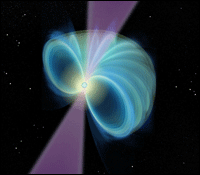 |

|
 |
Image: RUSSELL KIGHTLEY MEDIA
|
 |
|
An international team of astronomers has discovered a
new class of stars--massively compressed old neutron stars that seem
inactive but for intermittent bursts of radio waves. Dubbing them
rotating radio transients (RRATs), the researchers note that their
isolated outbursts last for as few as two milliseconds and are
separated by gaps as long as three hours.
"These things were very difficult to pin down," says Dick
Manchester of the Commonwealth Scientific and Industrial Research
Organization's (CSIRO) Australia Telescope National Facility. "For each
object we've been detecting radio emissions for less than one second a
day. And because these are single bursts, we've had to take great care
to distinguish them from terrestrial radio interference." |
| The astronomers' analysis suggests that these
neutron stars rotate like more regular pulsars, but only pulse
occasionally. If these stars belonged to binary systems, as some other
pulsars do, their reappearance from behind their partners might explain
the periodic bursts. The data seem to show that they are not, however.
Given the fact that the single, 35-minute observation that first
revealed these new stars had only a roughly 20 percent chance of
catching one of these outbursts, there may be as many as five times
more of these RRATs than the 100,000 or so constant pulsars in the
Milky Way. That makes these tempermental pulsars a more common member
of the universal star population than their more widely known pulsar
cousins. "This discovery increases the current galactic population
estimates [for pulsars] by at least several times," the team writes in
their report on the findings, published today in Nature.
"We therefore expect the emerging generation of wide-field radio telescopes to discover many more RRATs."
--David Biello
|